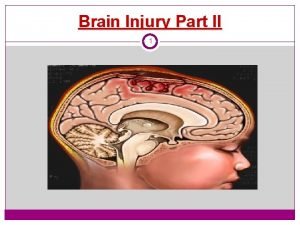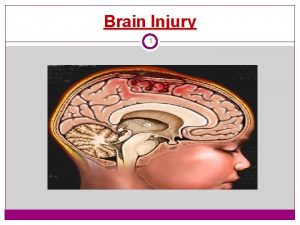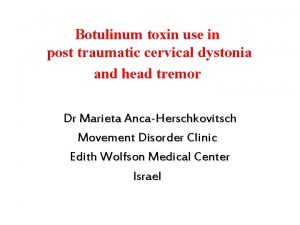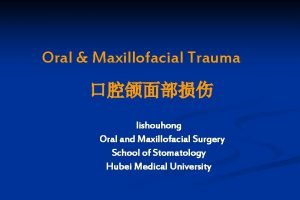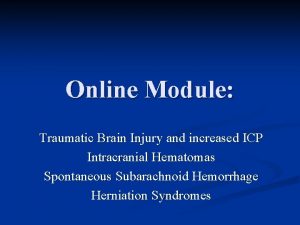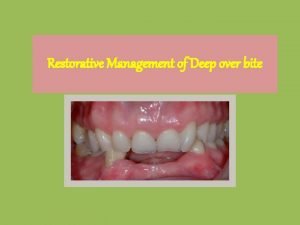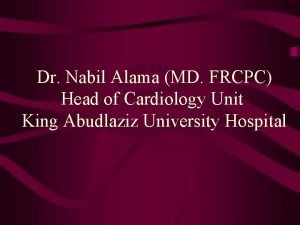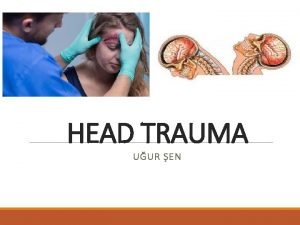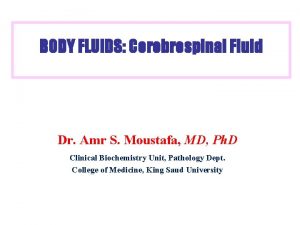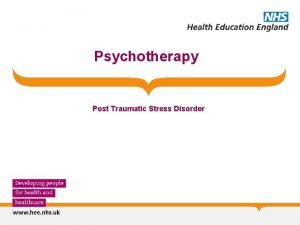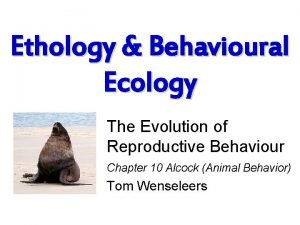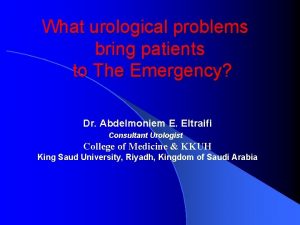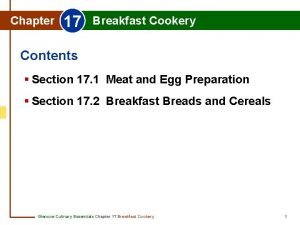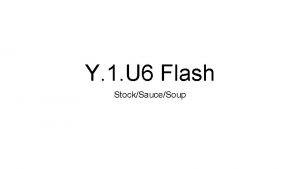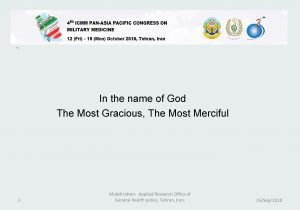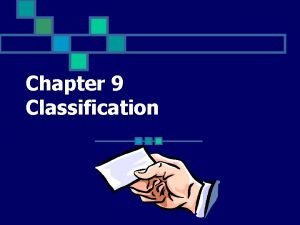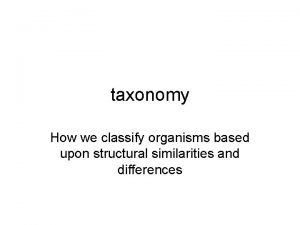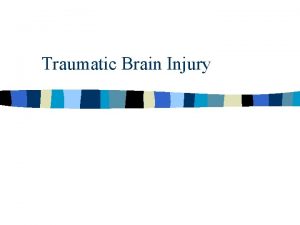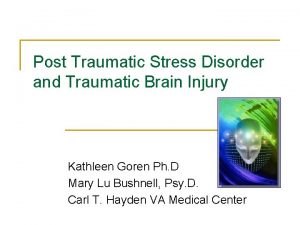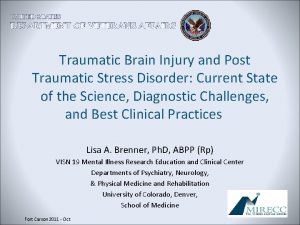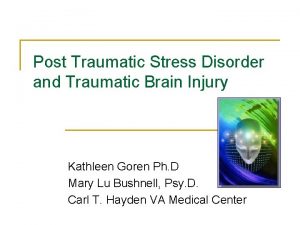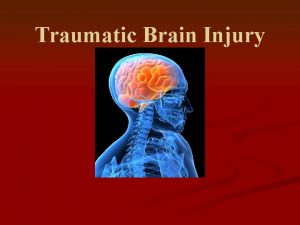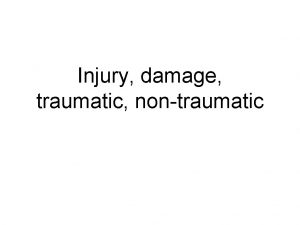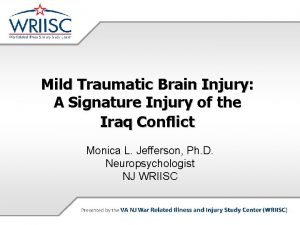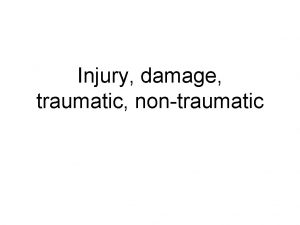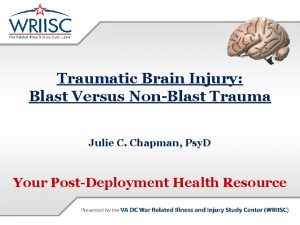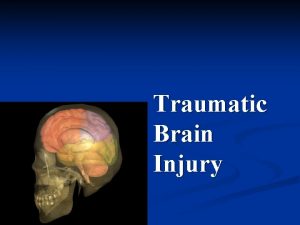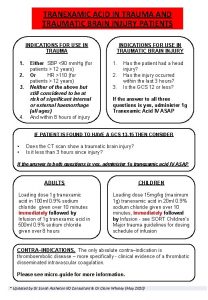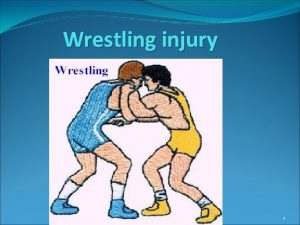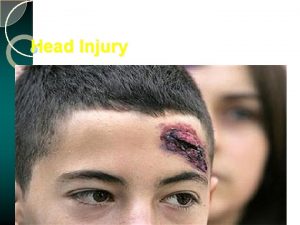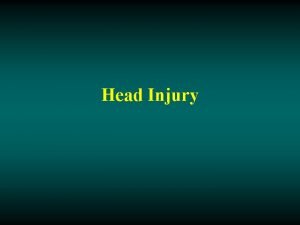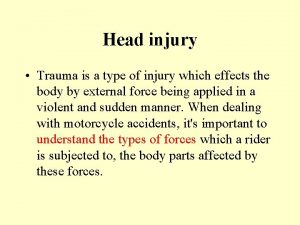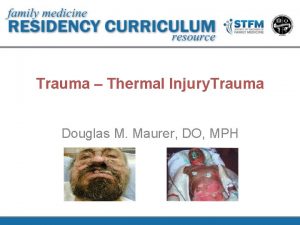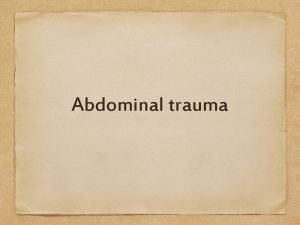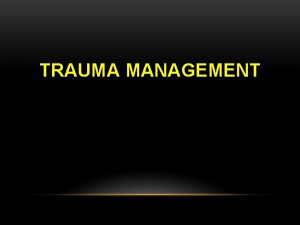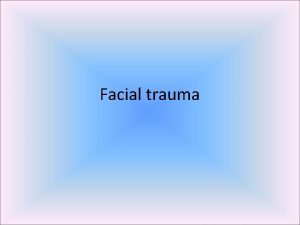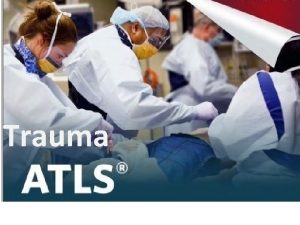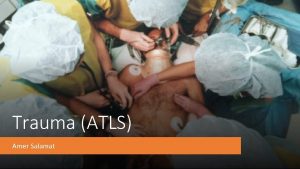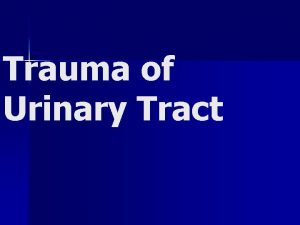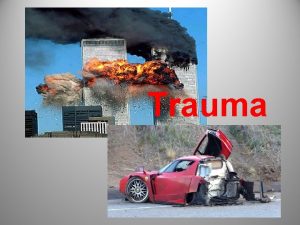6 Trauma most often refers to Traumatic injury

![외상이란? • 외상6 (外傷) • [명사] <의학> 몸의 겉에 생긴 상처를 통틀어 이르는 말. 외상이란? • 외상6 (外傷) • [명사] <의학> 몸의 겉에 생긴 상처를 통틀어 이르는 말.](https://slidetodoc.com/presentation_image_h/8c50ecd0415d38cd236cc593946e10ab/image-2.jpg)
































- Slides: 34

![외상이란 외상6 外傷 명사 의학 몸의 겉에 생긴 상처를 통틀어 이르는 말 외상이란? • 외상6 (外傷) • [명사] <의학> 몸의 겉에 생긴 상처를 통틀어 이르는 말.](https://slidetodoc.com/presentation_image_h/8c50ecd0415d38cd236cc593946e10ab/image-2.jpg)
외상이란? • 외상6 (外傷) • [명사] <의학> 몸의 겉에 생긴 상처를 통틀어 이르는 말. • Trauma most often refers to: • Traumatic injury, sudden physical injury caused by an external force, which does not rise to the level of major trauma • Major trauma, in physical medicine, severe physical injury caused by an external source https: //en. wikipedia. org/wiki/Trauma 2018 -08 -31 대한응급의료지도의사협의회 EMS 2018 2










Guidelines for field triage of injured patients 2011 • They are designed for use with individual injured patients and provide guidance for EMS providers who care for and transport patients injured in U. S. communities daily through motor-vehicle crashes, falls, penetrating injuries, and other injury mechanisms. 2018 -08 -31 대한응급의료지도의사협의회 EMS 2018 12

Guidelines for field triage of injured patients 2011 Vs 중증외상의 기준 CPR standard? CPR guideline! 2018 -08 -31 대한응급의료지도의사협의회 EMS 2018 13

Guidelines for field triage of injured patients 2011 Step One: Physiologic Criteria Step Two: Anatomic Criteria Step Three: Mechanism of Injury Step Four: Special Considerations 2018 -08 -31 대한응급의료지도의사협의회 EMS 2018 14


Step 1: Physiologic Criteria • Guidelines for field triage of injured patients 2011 OR * The upper limit of respiratory rate in infants is >29 breaths per minute to maintain a higher level of overtriage for infants. • 현장표준지침 및 외상세부상황표 생리학적 기준 • AVPU 의식수준 V이하 또는 글라스고우 혼수척도 ≤ 13 • 수축기 혈압 <90 mm. Hg • 분당 호흡수 <10 혹은 >29 2018 -08 -31 OR 대한응급의료지도의사협의회 EMS 2018 16


Step 3: Mechanism-of-Injury Criteria • Guidelines for field triage of injured patients 2011 ¶ Children : Age <15 years ** Intrusion refers to interior compartment intrusion, as opposed to deformation which refers to exterior damage. Includes pedestrians or bicyclists thrown or run over by a motor vehicle or those with estimated impact >20 mph with a motor vehicle. †† • 현장표준지침 및 외상세부상황표 손상기전에 따른 기준 • 낙상-성인 : 6 m 이상(건물 3층 높이 이상) / 소아 : 3 m 이상(건물 2층 높이 이상) • 고위험 교통사고 : 차체 눌림(찌그러짐, 30 cm 이상) / 자동차에서 이탈(튕겨져 나 감) / 동승자의 사망 / 차량 전복 • 자동차-보행자/자전거 충돌로 나가떨어짐, 치임 또는 시속 30 km 이상의 속도로 충돌함 • 오토바이 시속 30 km 이상의 속도 / 폭발에 의한 직접적 영향 2018 -08 -31 대한응급의료지도의사협의회 EMS 2018 18

Step 3: Mechanism-of-Injury Criteria • A retrospective study of approximately 1 million trauma patients indicated that using physiologic and anatomic criteria alone for triage of patients resulted in undertriage, implying that using MOI for determining trauma center need helped reduce the problem of undertriage (46). • whereas MOI criteria identified an additional 1, 449 (25. 3%) seriously injured patients with a modest (10%) incremental increase in overtriage (from 14. 0% to 25. 3%) (48). 2018 -08 -31 대한응급의료지도의사협의회 EMS 2018 19


Step 4: Special Considerations • Adults aged • High rates of undertriage in adults aged >65 years relative to other age groups • 49. 9% in >65 year and 17. 8% in other adult (p<0. 001) • Retrospective chart review of 2, 194 geriatric patients (aged ≥ 65 years) at a Level 1 trauma center, mortality was noted to increase at a SBP of <110 mm. Hg • A study of 57, 302 patients with ground-level falls demonstrated higher rates of intracranial injury and in-hospital mortality among adults aged ≥ 70 years • Anticoagulated patients taking clopidogrel had higher mortality rates (OR = 14. 7; 95% CI = 2. 3– 93. 6) and were more likely to be discharged to a long-term facility (OR = 3. 25; 95% CI = 1. 06– 9. 96) 2018 -08 -31 대한응급의료지도의사협의회 EMS 2018 21

Transport Step One: Physiologic Criteria Step “To emphasize the need for trauma system” “This change recognizes that the highest level of trauma care should be determined by the regional/state trauma system design and authority. ” Step Two: Anatomic Criteria Step Three: Mechanism of Injury Step Four: Special Considerations 2018 -08 -31 대한응급의료지도의사협의회 EMS 2018 22





현장 중증도 분류의 정확성 • JAMA Surg. 2018 Apr 1; 153(4): 322 -327. doi: 10. 1001/jamasurg. 2017. 4472. • Accuracy of Prehospital Triage in Selecting Severely Injured Trauma Patients. • More than 20% of the patients with severe injuries (ISS >15) were not transported to a level I trauma center. These patients are at risk for preventable morbidity and mortality. This finding indicates the need for improvement of the prehospital triage protocol. 2018 -08 -31 대한응급의료지도의사협의회 EMS 2018 27

현장 중증도 분류의 정확성 • J Am Coll Surg 2016; 222: 146 e 158. • Prospective Validation of the National Field Triage Guidelines for Identifying Seriously Injured Persons 2018 -08 -31 대한응급의료지도의사협의회 EMS 2018 28

손상기전과 중증도 분류 • Injury. 2014 May; 45(5): 869 -73. doi: 10. 1016/j. injury. 2013. 12. 010. Epub 2014 Jan 8. • Accuracy of the field triage protocol in selecting severely injured patients after high energy trauma. • The overall rate of undertriage (10. 8%) was mainly influenced by a high rate of undertriage in the group of patients with only a positive mechanism criterion • As a consequence these patients with severe injury are undetected using the current triage protocol. 2018 -08 -31 대한응급의료지도의사협의회 EMS 2018 29

연령과 중증도 분류 • J Emerg Med. 2018 Aug; 55(2): 278 -287. doi: 10. 1016/j. jemermed. 2018. 02. 001. Epub 2018 Apr 20. • The Age of Undertriage: Current Trauma Triage Criteria Underestimate The Role of Age and Comorbidities in Early Mortality. • Despite apparent evidence of both prehospital stability and stability upon arrival to the ED, patients ≥ 60 years of age and with a history of CHF or CVA have a significantly increased risk of early mortality after blunt trauma. • These patients are at risk for subsequent clinical deterioration and should be considered for early transfer to a trauma center with highest-level activation. 2018 -08 -31 대한응급의료지도의사협의회 EMS 2018 30

현장 중증도분류 체계 비교 • American Journal of Emergency Medicine 36 (2018) 1060– 1069 • Effectiveness of prehospital trauma triage systems in selecting severely injured patients: Is comparative analysis possible? • Systematic review : 1986~2017, US, Canada, EU • Prehospital trauma triage protocol • V/S, injury type, MOI • Age, comorbidity, EMS provider judgment in FTDS • Age, comorbidity, applied resuscitation in Vittel triage criteria 2018 -08 -31 대한응급의료지도의사협의회 EMS 2018 31

현장 중증도분류 체계 비교 • American Journal of Emergency Medicine 36 (2018) 1060– 1069 • Undertriage : 1. 1% ~ 68. 0% • Overtriage : 4. 7% ~ 88. 6% 2018 -08 -31 대한응급의료지도의사협의회 EMS 2018 32


 Traumatic brain injury concept map
Traumatic brain injury concept map Traumatic brain injury concept map
Traumatic brain injury concept map How to protect yourself from intentional injuries
How to protect yourself from intentional injuries Much to everyone's dislike the outspoken
Much to everyone's dislike the outspoken Post traumatic stress disorder
Post traumatic stress disorder Acute stress disorder diagnosis
Acute stress disorder diagnosis Post traumatic cervical dystonia
Post traumatic cervical dystonia Blunt traumatic asphyxia
Blunt traumatic asphyxia Sdh vs edh
Sdh vs edh Traumatic overbite
Traumatic overbite Tbi long term servival after traumatic
Tbi long term servival after traumatic Traumatic subdural hematoma
Traumatic subdural hematoma Csf traumatic tap
Csf traumatic tap Cptsd
Cptsd Damselfly
Damselfly Always usually sometimes rarely never
Always usually sometimes rarely never Most common site of ureteric injury during hysterectomy
Most common site of ureteric injury during hysterectomy Most common site of urethral injury
Most common site of urethral injury Breakfast cookery
Breakfast cookery Creole is a derivative sauce of
Creole is a derivative sauce of What is a crab dolly? when is it most often used?
What is a crab dolly? when is it most often used? In the name of god the most gracious the most merciful
In the name of god the most gracious the most merciful In the name of allah the most beneficent the most merciful
In the name of allah the most beneficent the most merciful Arrangement of organisms
Arrangement of organisms In the name of allah the most
In the name of allah the most Most general to most specific classification
Most general to most specific classification In the name of allah the most beneficent
In the name of allah the most beneficent Beneficent pronunciation
Beneficent pronunciation In the name of god most gracious most merciful
In the name of god most gracious most merciful In the name of god most gracious prayer
In the name of god most gracious prayer Most general to most specific classification
Most general to most specific classification Guddi baji
Guddi baji Aqaid e islam
Aqaid e islam In the name of allah the most gracious
In the name of allah the most gracious Most general to most specific classification
Most general to most specific classification
